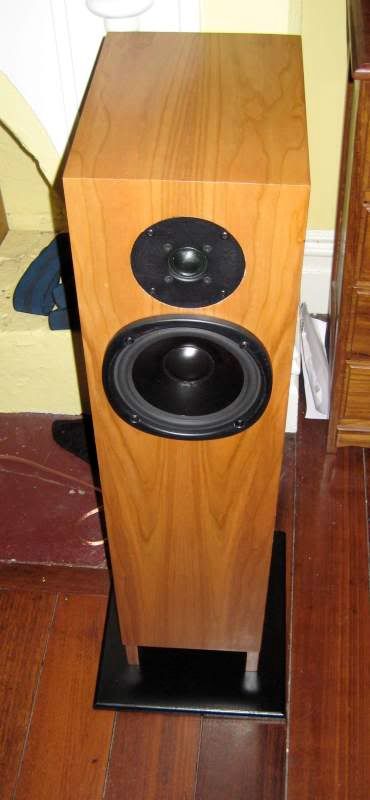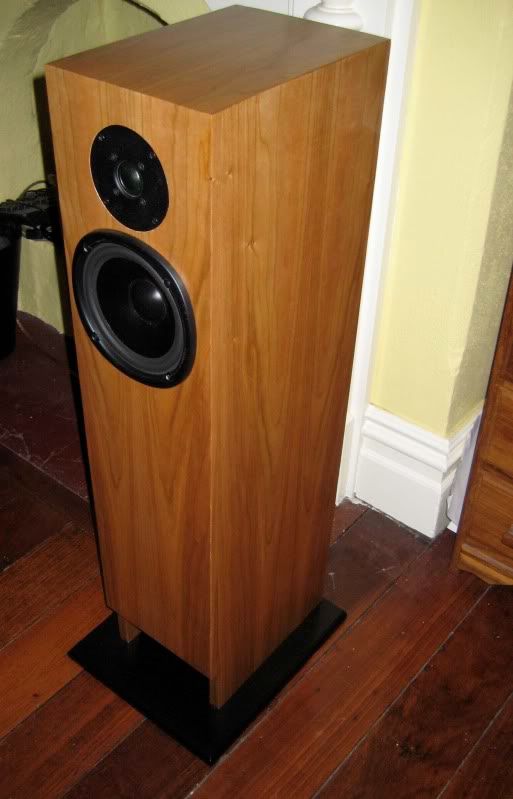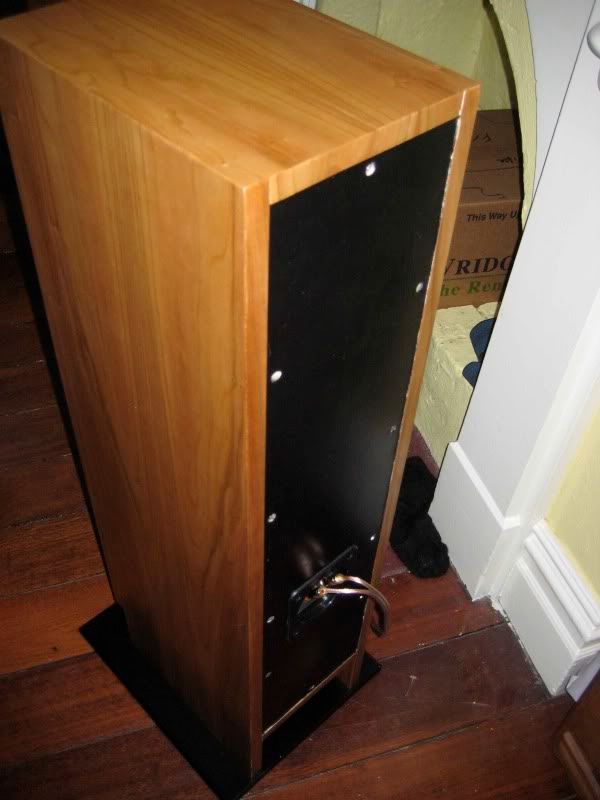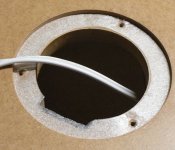How much of a difference does rounding the edges of the baffle make, seems like it will provide a lot of hassle for veneering, I have natural lay on veneer American Cherry.
Will installing the drivers slightly off centreline make a difference for both Woofer and Tweeter?
Do cross over caps have polarity? I can't seem to see anything on the ones I have.
We are getting close now.
vovo
Will installing the drivers slightly off centreline make a difference for both Woofer and Tweeter?
Do cross over caps have polarity? I can't seem to see anything on the ones I have.
We are getting close now.
vovo
Last edited:
Matt
I'm not familiar with the amp but all 240VAC inputs should be fused. Generally the size is dictated by the transformer VA and check the supplier as they usually have the info. For toroidals you can use 0.5A to 50VA, 1A to 80VA, 3A to 160VA, 5A to 300VA. These are slow blow fuses.
I'm not familiar with the amp but all 240VAC inputs should be fused. Generally the size is dictated by the transformer VA and check the supplier as they usually have the info. For toroidals you can use 0.5A to 50VA, 1A to 80VA, 3A to 160VA, 5A to 300VA. These are slow blow fuses.
How much of a difference does rounding the edges of the baffle make, seems like it will provide a lot of hassle for veneering, I have natural lay on veneer American Cherry.
Will installing the drivers slightly off centreline make a difference for both Woofer and Tweeter?
Do cross over caps have polarity? I can't seem to see anything on the ones I have.
We are getting close now.
vovo
vovo
Rounding has no benefit unless it's large.... say > 50R.
Off centre will make little if any difference on this speaker. It you do it use a ratio that's an irrational number but you are quite safe with about 20mm offset. Maybe more benefit if only off setting the tweeter and leave the woofer on the centreline. If it's a routing mistake don't worry about it. There is a program around called the Edge that can tell you those sort of things.
If they are polypropylene caps then they are not polarised so can be connected either way. Some brands such as Auricaps have a prefered connection in their data. Have a look at the brand's info and see if they have a preference. There's been plenty of arguements and discussions on this over the years. Polarised electrolytics are a different matter.
I have seen information that inductors should be wired so the input goes to the wire that goes to the inner coil. I've tried it both ways and can't pick a difference but I do make sure all the inductors are wired the same for peace of mind.
You may be first to blast off.

What type of silicone/ sealant do we use for sealing speaker boxes and for use as a gasket for speakers.
I have the back panel removable (screwed into Jarrah) and would like to ensure that it is sealed when screwed on.
What do you guys use for sealing your boxes?
Do you guys glue your ports in, mine has a very tight fit, but it is downward firing, so gravity and vibrations might help it move over time, would a bit of silicone around the port on the inside hold it enough.
I have decided not to rebate the woofer, its not a round circle and using a router is quite difficult.
Otherwise everything is on track to have it finished in the next couple of weeks, I have decided to veneer it using lay on veneer in American cherry, I much prefer African hardwoods but choosing a veneer was very painful, so I just chose a trusted speaker finish.
I have the back panel removable (screwed into Jarrah) and would like to ensure that it is sealed when screwed on.
What do you guys use for sealing your boxes?
Do you guys glue your ports in, mine has a very tight fit, but it is downward firing, so gravity and vibrations might help it move over time, would a bit of silicone around the port on the inside hold it enough.
I have decided not to rebate the woofer, its not a round circle and using a router is quite difficult.
Otherwise everything is on track to have it finished in the next couple of weeks, I have decided to veneer it using lay on veneer in American cherry, I much prefer African hardwoods but choosing a veneer was very painful, so I just chose a trusted speaker finish.
For gaskets I go to "Clark Rubber" and get some thin foam filler rod, usually the 6 or 8 millimeter stuff, don't use silicon for the woofer gasket;-( (I did that once and ruined a SEAS 10 inch woofer when it had to be removed )
Inside I have used silicon and Acrylic gap sealer the acrylic is much cheaper, I have also used a mixture of shredded newspaper, PVA and Plaster of Paris with big fillets
Inside I have used silicon and Acrylic gap sealer the acrylic is much cheaper, I have also used a mixture of shredded newspaper, PVA and Plaster of Paris with big fillets
I think silicone sealants can react with drivers if not cured fully. There was a thread about that somewhere.
Jaycar and others do sell a self adhesive foam for sealing drivers and there's also window sealing self adhesive tapes that will do the job. Even that white thin (1-2mm) foam stuff they use to pack around electronic components works well and I use that under tweeters.
If the box has tight joints and has been glued with PVA or similar, you should need to seal any joins. I do seal the MDF inside my enclosures with a water based polyurethane (Estapol Water Based Clear) but watered down PVA works as well.
Jaycar and others do sell a self adhesive foam for sealing drivers and there's also window sealing self adhesive tapes that will do the job. Even that white thin (1-2mm) foam stuff they use to pack around electronic components works well and I use that under tweeters.
If the box has tight joints and has been glued with PVA or similar, you should need to seal any joins. I do seal the MDF inside my enclosures with a water based polyurethane (Estapol Water Based Clear) but watered down PVA works as well.
What I will add is the basket of the Audax is pressed steel with 4 screw holes so not tolerant to thick gaskets being squeezed flat (will buckle). When installing do not over tighten. IIRC when installed in the Richter they had no gaskets.
I think that Jaycar stuff may be too sticky (looks like a Bostik thingy) and requires compression so would be no good if the driver had to be removed.
Raven Seal (Bunnings etc) make an open foam seal for window seals and compresses very easily and is self adhesive.
The stuff I was referring to is the shipping protection they place over screens on LCD and Plasmas TV's as well on front panels on amps and DVD players. Here's a pic with some cut to suit a tweeter gasket. I can't remember what it's called. What makes it very good is it doesn't stick to the box or driver which makes removal easier.
I think that Jaycar stuff may be too sticky (looks like a Bostik thingy) and requires compression so would be no good if the driver had to be removed.
Raven Seal (Bunnings etc) make an open foam seal for window seals and compresses very easily and is self adhesive.
The stuff I was referring to is the shipping protection they place over screens on LCD and Plasmas TV's as well on front panels on amps and DVD players. Here's a pic with some cut to suit a tweeter gasket. I can't remember what it's called. What makes it very good is it doesn't stick to the box or driver which makes removal easier.
Attachments
The Jaycar sealant is like stiff "Blu-tack" if you get the thinnest of the filler rods is OK ( 3mm ) but you would be putting pressure on with anything else, blotting paper may work too
Surely blotting paper is porous? Wouldn’t something like a couple layers of carbon paper or even clingwrap work better. Maybe an elastic band for the tweeter?
Surely blotting paper is porous? Wouldn’t something like a couple layers of carbon paper or even clingwrap work better. Maybe an elastic band for the tweeter?
Elastic bands degrade quickly and go really sticky and hard to clean off; to be honest I haven't tried blotting paper but have you ever tried breathing thru the stuff, I have on my desk some polyethylene wrapping paper from Oz-Post that would probably work too as would plasticine or putty
Hey guys sorry to bug you again. Hopefully not much longer.
Speaker cabinets are built, just need to be finished (hopefully this weekend).
In rabbitz design, the positive is connected to the tweeter negative, I recall this is intentional, what is the reason for this?
For the thinner damping material on the sides and the top of the box, can I just separate some of the thick stuff I have from Jaycar, Will a third of that thickness do?
Really appreciate the help.
Thanks
Speaker cabinets are built, just need to be finished (hopefully this weekend).
In rabbitz design, the positive is connected to the tweeter negative, I recall this is intentional, what is the reason for this?
For the thinner damping material on the sides and the top of the box, can I just separate some of the thick stuff I have from Jaycar, Will a third of that thickness do?
Really appreciate the help.
Thanks
The reverse polarity is due to the 2nd order crossover and brings the tweeter back in phase. If connected +ve to +ve then you would get a null at the crossover point.... actually when modelling we look for a deep null which indicates good phase tracking when wired correctly.
The Jaycar stuff is not dense enough for that purpose. If you don't have anything, don't worry about it as sometimes I use it and other times I don't... depends what I have around at the time. I generally use a white felt ironing board underlay (6mm thick I think) that I buy at Coles for around AU$7. The felt (speckled grey stuff) used by removalists works as well. It's there to cover the hard surface inside the box to reduce reflections.... sort of like a large window that reflects sound and when you close the curtain, you get less reflections.
The Jaycar stuff is not dense enough for that purpose. If you don't have anything, don't worry about it as sometimes I use it and other times I don't... depends what I have around at the time. I generally use a white felt ironing board underlay (6mm thick I think) that I buy at Coles for around AU$7. The felt (speckled grey stuff) used by removalists works as well. It's there to cover the hard surface inside the box to reduce reflections.... sort of like a large window that reflects sound and when you close the curtain, you get less reflections.
Just a finishing question.
When applying polyurethane, do you apply to only horizontal surfaces, or do you coat the whole thing and let it dry, is there a max time between coats? Would I be able to do one coat a day? in the evenings after work?
When applying polyurethane, do you apply to only horizontal surfaces, or do you coat the whole thing and let it dry, is there a max time between coats? Would I be able to do one coat a day? in the evenings after work?
Depends on the product.
I use Estapol Satin and can be applied to vertical or horizontal surfaces but you just have to be careful not to apply too thick per coat as you can get runs. When doing each surface I wipe away any residue that goes onto the next face but brushing towards the corners eliminates that problem.
I don't know about a maximum time but second coats can be applied after 8 hours if the weather is warm and not humid. After coating it's best to wait a couple of days before installing drivers if they sit on the coated surface as they can stick.
I use Estapol Satin and can be applied to vertical or horizontal surfaces but you just have to be careful not to apply too thick per coat as you can get runs. When doing each surface I wipe away any residue that goes onto the next face but brushing towards the corners eliminates that problem.
I don't know about a maximum time but second coats can be applied after 8 hours if the weather is warm and not humid. After coating it's best to wait a couple of days before installing drivers if they sit on the coated surface as they can stick.
well my speakers were finished on Lucky friday 13, so I guess good times are ahead.
I have been listening to them on low volume and haven't yet been able to give them a good high volume listen.
Well anyways here they are.




I have been listening to them on low volume and haven't yet been able to give them a good high volume listen.
Well anyways here they are.




1Excellent woodwork.
Congratulations.
Let us know your listening impressions when you have listened for a while
Regards
Moondog
Congratulations.
Let us know your listening impressions when you have listened for a while
Regards
Moondog
Awesome work vovo, put's mine to shame. I think that'll be my next project, rather then new speakers turning these into floorstanders... because to be honest my first box effort is sub-standard. 😱
However, I'm really looking forward to finishing these speakers but the amount of school and basketball at the moment is ridiculous.
Can't wait for the holidays and to hear these beauties!
Matt.😀
However, I'm really looking forward to finishing these speakers but the amount of school and basketball at the moment is ridiculous.
Can't wait for the holidays and to hear these beauties!
Matt.😀
- Status
- Not open for further replies.
- Home
- Loudspeakers
- Multi-Way
- Kit in Australia
